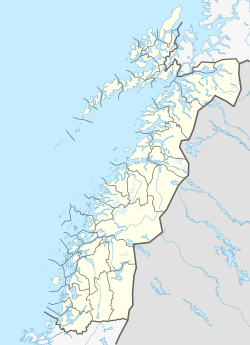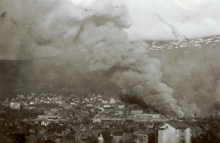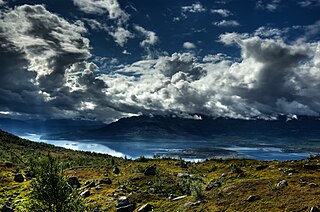
Norrbotten County is the northernmost county or län of Sweden. It is also the largest county by land area, almost a quarter of Sweden's total area. It shares borders with Västerbotten County to the southwest, the Gulf of Bothnia to the southeast, the counties of Nordland and Troms in Norway to the northwest, and Lapland Province in Finland to the northeast.
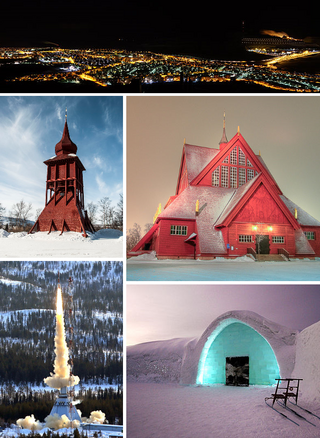
Kiruna is the northernmost city in Sweden, situated in the province of Lapland. It had 17,002 inhabitants in 2016 and is the seat of Kiruna Municipality in Norrbotten County. The city was originally built in the 1890s to serve the Kiruna Mine.

Narvik is the third-largest municipality in Nordland county, Norway, by population. The administrative centre of the municipality is the town of Narvik. Some of the notable villages in the municipality include Ankenesstranda, Ballangen, Beisfjord, Bjerkvik, Bjørnfjell, Elvegård, Kjøpsvik, Skjomen, Håkvik, Hergot, Straumsnes, and Vidrek. The Elvegårdsmoen army camp is located near Bjerkvik.
The Battles of Narvik were fought from 9 April to 8 June 1940, as a naval battle in Ofotfjord and as a land battle in the mountains surrounding the north Norwegian town of Narvik, as part of the Norwegian Campaign of the Second World War.

Sweden maintained its policy of neutrality during World War II. When the war began on 1 September 1939, the fate of Sweden was unclear. But by a combination of its geopolitical location in the Scandinavian Peninsula, realpolitik maneuvering during an unpredictable course of events, and a dedicated military build-up after 1942, Sweden kept its official neutrality status throughout the war. At the outbreak of hostilities, Sweden had held a neutral stance in international relations for more than a century, since the end of the Napoleonic Wars in 1814 and the invasion of Norway.
Swedish iron ore was an important economic and military factor in the European theatre of World War II, as Sweden was the main contributor of iron ore to Nazi Germany. The average percentages by source of Nazi Germany’s iron ore procurement through 1933–43 by source were: Sweden: 43.0 Domestic production (Germany): 28.2 France: 12.9. Within the German military the Navy was most dependent on Swedish steel as an absolute necessity to the German war effort, according to their grand admiral. It has also been argued that the Swedish export helped prolong the war.

The Norwegian campaign involved the attempt by Allied forces to defend northern Norway coupled with the resistance of the Norwegian military to the country's invasion by Nazi Germany in World War II.
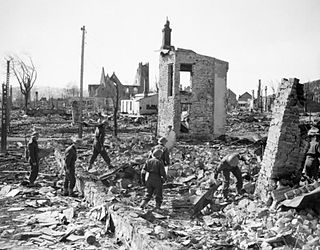
The Namsos campaign, in Namsos, Norway, and its surrounding area involved heavy fighting between Anglo-French and Norwegian naval and military forces on the one hand, and German military, naval and air forces on the other in April and early May 1940. It was one of the first significant occasions during the Second World War when British and French land forces fought the German Army.
The Norwegian Campaign, lasting from 9 April to 10 June 1940, led to the first direct land confrontation between the military forces of the Allies—the United Kingdom and France— against Nazi Germany in World War II.
Operation Wilfred was a British naval operation during the Second World War that involved the mining of the channel between Norway and its offshore islands to prevent the transport of Swedish iron ore through neutral Norwegian waters to be used to sustain the German war effort. The Allies assumed that Wilfred would provoke a German response in Norway and prepared a separate operation known as Plan R 4 to occupy Narvik and other important locations.

The Ofoten Line is a 43-kilometre (27 mi) railway line in Narvik, Norway. It runs from the Port of Narvik to Riksgränsen on the Norway–Sweden border, where the line continues as the Ore Line via Kiruna and Gällivare to Luleå. The Ofoten Line is single track, electrified at 15 kV 16.7 Hz AC and has seven stations. The line only connects to the rest of the Norwegian railway network via Sweden. The main traffic is up to 12 daily freight trains operated by Malmtrafik that haul iron ore from Sweden to Narvik. In addition, CargoNet operates container trains, branded as the Arctic Rail Express (ARE), and Vy Tåg operates passenger trains, including a night train to Stockholm.

The Iron Ore Line is a 398-kilometre (247 mi) long railway line between Riksgränsen and Boden in Norrbotten County, Sweden, owned by Trafikverket. The line also contains two branches, from Kiruna to Svappavaara and from Gällivare to Koskullskulle. The term is often colloquially used to also include the Ofoten Line, from Riksgränsen to Narvik in Norway, and the northernmost part of the Main Line Through Upper Norrland from Boden to Luleå. The railway from Narvik to Luleå is 473 kilometres (294 mi) long.

HNoMS Rauma was an Otra-class minesweeper built in 1939 for the Royal Norwegian Navy. Captured by the Germans during the 1940 invasion of Norway and renamed Kamerun, she was returned to the Norwegians after the end of the Second World War and recommissioned in 1947. Rauma remained in service until being sold for scrapping in 1963.

LKAB Malmtrafik, earlier Malmtrafik i Kiruna AB (MTAB), is a Swedish railway company which operates the iron ore freight trains on the Iron Ore Line and the Ofoten Line. MTAB is a wholly owned subsidiary of the mining company Luossavaara–Kiirunavaara (LKAB). In Norway, operations are handled by the subsidiary Malmtrafikk AS (MTAS). Malmtrafik hauls ore from LKAB's mines in Kiruna, Malmberget and Svappavaara to the ports of Luleå and Narvik, the latter located in Norway. The company owns 28 Iore locomotives and 750 hopper cars. Each train is 68 cars long and weighs 8,600 tonnes, allowing the company to transport 33 million tonnes per year.

The Reichskommissariat Norwegen was the occupation regime set up by Nazi Germany in German-occupied Norway during World War II. Its full title in German was the Reichskommissariat für die besetzten norwegischen Gebiete. It was governed by Reichskommissar Josef Terboven until his deposition on 7 May 1945. The German military forces in Norway, then under the command of general Franz Böhme, surrendered to the Allies on 9 May and the legal government was restored.

Plan R 4 was an unrealised British plan to invade Norway and Sweden in April 1940, during the Second World War. As a result of competing plans for Norway and a German invasion of Norway the same month, it was not carried out as designed. Similar plans had been drawn up during the proposed Anglo-French intervention in the Winter War.

During the early stages of World War II, the United Kingdom and France made a series of proposals to send troops to assist Finland against the Soviet Union during the Winter War, which started on 30 November 1939. The plans involved the transit of British and French troops and equipment through neutral Norway and Sweden. The initial plans were abandoned because Norway and Sweden declined transit through their land for fear that their countries would be drawn into the war. The Moscow Peace Treaty ended the Winter War in March 1940, which precluded the possibility of intervention.

Operation Weserübung was the invasion of Denmark and Norway by Nazi Germany during the Second World War and the opening operation of the Norwegian Campaign.

Empire Endurance was a 8,514 GRT steam cargo liner that was built in 1928 as Alster by Deschimag Werk Vulkan, Hamburg, Germany for the shipping company Norddeutscher Lloyd. In the years leading up to the Second World War Alster carried cargo and passengers between Germany and Australia. After the outbreak of war she was requisitioned by the Kriegsmarine for use as a supply ship.
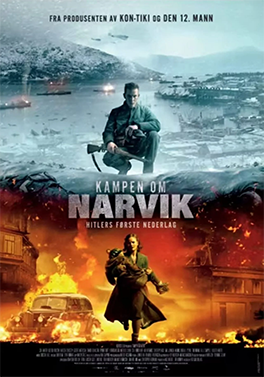
Narvik is a Norwegian historical film depicting the Battles of Narvik from 9 April to 8 June 1940. Directed by Erik Skjoldbjærg and made by Nordisk Film, it stars Kristine Hartgen, Carl Martin Eggesbø, Cristoph Gelfert Mathiesen and Henrik Mestad. The film premiered in Norway in December 2022 and was released worldwide on Netflix in January 2023.

